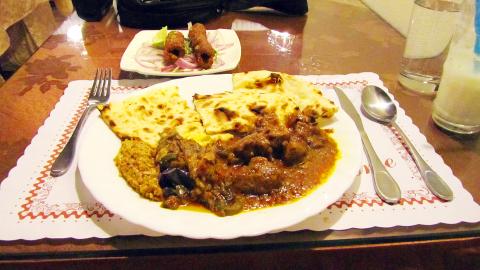Ali Baba’s has long been a fixture on Nanjing East Road, serving up some of the best Indian food to be found in Taipei. In truth there isn’t much competition, with visits to other curry restaurants in
the capital tending to provide dining experiences running from the disappointing to the downright awful.
The decor at Ali Baba’s is showing its age a bit — and dark brown is perhaps not the most inspiring choice of paint color for the ceiling — but the food consistently hits the mark, a fact highlighted by the number of South Asian habitues.

PHOTO: TONY PHILLIPS, TAIPEI TIMES
If you are unfamiliar with Indian food, the extensive buffet is a good way of testing the culinary waters. There are mutton, chicken, seafood and vegetable curries, chutneys, different types of starters, rice, naan bread and even desserts and fruit. In short, if you’re unable to find something to suit your tastes, Indian food probably isn’t for you.
The buffet, which is usually only served at lunchtime on weekends, costs NT$399 plus service. If the latter charge seems odd for a serve yourself affair, soft drinks such as cola, tea or lassi (a sweet, salty or mango-flavored yogurt drink) are included in the price and will be brought to you by a waiter. Service is invariably willing and friendly.
The a la carte menu contains the usual Indian restaurant staples such as tandoori mixed grill, saag gosht (a spiced mutton and spinach dish), assorted birianis and even a few fish dishes.
There is a fair selection of vegetarian options, including palak paneer, which marries spinach and cubes of paneer, a very mild South Asian cheese with a consistency somewhere between tofu and feta cheese.
The naan breads are freshly baked and include keema naan (stuffed with mincemeat) and garlic naan.
Alcohol is not served, but you can bring your own.
My most recent visit, on a Saturday evening, brought the pleasant surprise of the buffet being available, although the waiter said this was a one-off.
I decided to load up on starters opting for the tandoori chicken, vegetable samosas, pakoras and naan. The dryish, somewhat spicy chicken was nicely complemented by the fresh tasting rings of slightly caramelized onions that it
came with.
The samosas — triangular-shaped pastries stuffed with potato and peas — and pakoras — a kind of onion fritter — were crisp and mildly spiced, accompanied by a somewhat sweet, light green mint and yogurt sauce.
I then tried the mutton korma, accompanied by eggplant curry, daal (a lentil dish), seekh kebab and more naan. Rice may have proven a better option second time round as the naan is filling, especially when combined with the rich korma.
None of the dishes was overly spicy, but if that’s your thing you can always go for the vindaloo on the a la carte menu.
Adding to the authenticity of the experience, there’s a TV screen in the dining area which often has Bollywood style music videos playing or sometimes cricket.
Occasionally the ambience may be disturbed by a shrill squawking, but fear not, it’s only the resident macaw, who from time to time makes an appearance on his perch.

Many people noticed the flood of pro-China propaganda across a number of venues in recent weeks that looks like a coordinated assault on US Taiwan policy. It does look like an effort intended to influence the US before the meeting between US President Donald Trump and Chinese dictator Xi Jinping (習近平) over the weekend. Jennifer Kavanagh’s piece in the New York Times in September appears to be the opening strike of the current campaign. She followed up last week in the Lowy Interpreter, blaming the US for causing the PRC to escalate in the Philippines and Taiwan, saying that as

Taiwan can often feel woefully behind on global trends, from fashion to food, and influences can sometimes feel like the last on the metaphorical bandwagon. In the West, suddenly every burger is being smashed and honey has become “hot” and we’re all drinking orange wine. But it took a good while for a smash burger in Taipei to come across my radar. For the uninitiated, a smash burger is, well, a normal burger patty but smashed flat. Originally, I didn’t understand. Surely the best part of a burger is the thick patty with all the juiciness of the beef, the

This year’s Miss Universe in Thailand has been marred by ugly drama, with allegations of an insult to a beauty queen’s intellect, a walkout by pageant contestants and a tearful tantrum by the host. More than 120 women from across the world have gathered in Thailand, vying to be crowned Miss Universe in a contest considered one of the “big four” of global beauty pageants. But the runup has been dominated by the off-stage antics of the coiffed contestants and their Thai hosts, escalating into a feminist firestorm drawing the attention of Mexico’s president. On Tuesday, Mexican delegate Fatima Bosch staged a

Would you eat lab-grown chocolate? I requested a sample from California Cultured, a Sacramento-based company. Its chocolate, not yet commercially available, is made with techniques that have previously been used to synthesize other bioactive products like certain plant-derived pharmaceuticals for commercial sale. A few days later, it arrives. The morsel, barely bigger than a coffee bean, is supposed to be the flavor equivalent of a 70 percent to 80 percent dark chocolate. I tear open its sealed packet and a chocolatey aroma escapes — so far, so good. I pop it in my mouth. Slightly waxy and distinctly bitter, it boasts those bright,